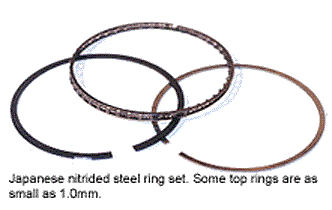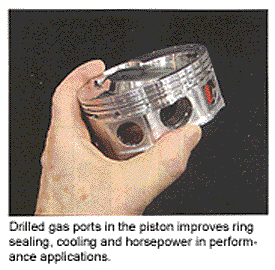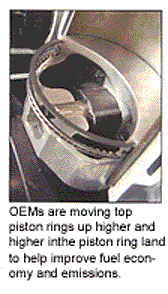Piston rings have one of the toughest jobs inside an engine. They’re slammed up and down between the ring lands thousands of times a minute; they’re subjected to searing temperatures and extreme pressures; and they’re constantly scraping back and forth against the cylinder walls. In spite of all of this, the rings are expected to seal combustion and vacuum, prevent blowby, control oil consumption, keep the cylinder walls lubricated, cool the pistons, and last, but certainly not least, last almost forever (150,000 miles plus in a passenger car/light truck engine or up to a million miles in a heavy-duty over-the-road diesel)!
It’s a demanding list, yet most rings are up to the task and hold up pretty well – assuming the "right" rings are used for the application, the cylinders are finished properly and the rings are installed on the pistons correctly. Obviously, the ring sealing requirements of a high -revving racing engine or a hard-working diesel engine are much more demanding than those of a mild stock engine. So with that in mind, let’s look at some of the latest thinking as it applies to piston ring designs, materials and coatings.
STOCK RINGS
With so many late model engines running thinner low-tension moly-faced ductile iron and steel rings, one might think cast iron rings are fading into history. They are at the OEM level, but it looks like cast iron rings will be around for a long, long time in the aftermarket. According to several ring suppliers, there is still a very strong demand for plain cast iron rings among engine rebuilders. The main reason is that cast iron rings cost less than more durable materials – and they hold up well enough in light-duty stock rebuilt engines.
A plain cast iron ring that’s designed for an older pushrod V8 or V6 can give an engine rebuilder a cost advantage over a higher priced ring set. Even so, plain cast iron rings won’t provide the durability of a chrome or moly-faced ring set, or a ring set that is engineered for high output late model overhead cam engines.
The secret of using plain cast iron rings successfully is to thoroughly clean the cylinder bores after they have been finish honed. Plain cast iron rings don’t have a hard facing to resist wear, so they require a very clean surface. The cylinders should be washed and scrubbed out with hot soapy water to remove all traces of honing abrasive and metal residue from the surface. Using a plateau finish will allow the rings to seat almost immediately to extend life and reduce blowby.
LATE MODEL RING SETS
Ring sets in late model engines are running hotter than ever before. As rings move up higher and higher on the piston to reduce emissions, they are exposed to more heat. A decade ago, the land width between the top ring groove and piston crown was typically 7.5 to 8.0 mm. Today that distance has decreased to only 3.0 to 3.5 mm in some engines. This minimizes the crevice just above the ring that traps fuel vapor and prevents it from being completely burned when the air/fuel mixture is ignited (this lowers emissions). But the top ring’s location also means it is exposed to much higher operating temperatures.
The top ring on many engines today run at close to 600° F, while the second ring is seeing temperatures of 300° F or less. Ordinary cast iron compression rings that work great in a stock 350 Chevy V8 can’t take this kind of heat. That’s why many late model engines have steel or ductile iron top rings. Steel is more durable than plain cast iron or even ductile iron, and is required for high output, high load applications including turbocharged and supercharged engines as well as diesels and performance engines.
Under the top compression ring is the number two ring, which is the second compression ring. The number two ring assists the top ring in sealing combustion, and also helps the oil ring below it with oil control. Most second rings have a tapered face with a reverse-twist taper face. This creates a sharp edge that scrapes against the cylinder wall for better oil control. Some new second ring designs are now using a "napier" style edge that has more of a squeegee effect as it scrapes along the cylinder wall. This helps reduce friction and oil consumption even more.
Second compression rings in late model engines are still mostly cast iron because they don’t see as much heat as the top compression ring. On domestic engines, the first and second rings are moly-faced, but on many Japanese engines the rings are nitrided.
The third ring is the oil ring. This is typically a three-piece ring (though some are four-piece, two-piece or even one-piece) that helps spread oil on the cylinder wall for lubrication and scrapes off the excess oil to prevent oil burning. In three-piece oil rings, there are two narrow side rails and an expander that wraps around the piston. The expander exerts both a sideways and outward pressure on the side rails so they will seal tightly against the cylinder walls.
LOW TENSION RINGS
Over the years, rings have been getting smaller and thinner. Typical ring sizes today in domestic engines are 1.2 mm for the top compression ring, 1.5 mm for the second ring, and 3.0 mm for the oil ring. Some are even thinner. The Buick 3800 V6 uses a narrow 2.0 mm thick oil ring.

The Japanese are going even smaller. Some Japanese engines now have 1.0 mm and even 0.8 mm top compression rings. The Japanese don’t use moly facings but prefer gas nitrided rings for added longevity. North American ring manufacturers say nitriding is too expensive and moly works better because it is porous, holds oil and is more scuff resistant. Even so, nitriding remains popular in Japan.
The Europeans, by comparison, use a mix of ring facings: moly, chrome and nitride. Like the Japanese and domestic OEMs, they too are using smaller and smaller rings. But much of the ring development work that’s going on in Europe today is now aimed at small diesel engines. The Europeans are buying more diesel-powered cars than gasoline-powered cars because of the diesel’s higher fuel economy. They don’t have the same emission regulations as we do, so diesels are a popular engine there.
Diesel engines run leaner and hotter than gasoline engines, so hard, durable ring facings are needed to provide good longevity. Moly works well in diesels, but new composite coatings that combine ceramics, moly and other ingredients provide increased longevity.
Engine manufacturers have been going to smaller rings because the rings alone can account for up to 40 percent of an engine’s internal friction. Thinner rings exert less tension against the cylinders. This reduces friction and improves fuel economy. And on high performance racing engines, less friction means more usable horsepower. But low friction rings also require rounder cylinder bores, too. That’s why many late model engines have torque-to-yield (TTY) head bolts and multi-layer steel (MLS) head gaskets. Both reduce bore distortion when the heads are installed on the block.
Low tension rings also weigh less and reduce the reciprocating mass that pounds against the piston grooves with every stroke of the piston. But groove pound out and microwelding are still a concern because of the higher operating temperatures in today’s engines. To counteract this, some rings have a special coating on the sides to keep them from sticking as they bounce up and down in the piston groove. And the pistons themselves have been improved to make them more heat resistant and durable.
Pistons are cooled partially by heat conduction through the rings to the cylinder walls, by oil splash from underneath and by the incoming air/fuel charge. The use of thinner, low tension rings reduces heat transfer via conduction causing the piston to run hotter. With a standard F-132 alloy piston, hotter means more thermal expansion and a need for greater clearance between the piston and cylinder to prevent scuffing – exactly the opposite of what’s desired in today’s engines to reduce blowby, emissions and noise.
Most engines today have very tight piston-to-wall clearances (.001? or less) to minimize blowby and reduce piston rock. The more stable the piston, the better it is able to maintain a tight seal. Close tolerances also make for a quieter running engine, especially after a cold start when clearances are greatest). To keep clearances to a minimum in such circumstances, an alloy with a lower coefficient of thermal expansion is required.
Many pistons today are made of a "hypereutectic" alloy for this reason. Hypereutectic pistons have a coefficient of thermal expansion that is about 15 percent less than standard F-132 alloy pistons. Consequently, hypereutectic pistons can be installed with a much tighter fit – up to .0005? less clearance may be needed depending on the application. Hypereutectic pistons with moly coatings on the side can handle even less clearance.
The tensile strength of hypereutectic pistons and conventional cast pistons is about the same, but the high temperature fatigue strength of hypereutectic alloys is better than either cast or forged alloys. This eliminates ring pound out problems in the top oil ring groove and the need for an iron insert.
On some pistons (GM 3800 supercharged V6, for example), the crown and top ring groove are anodized to improve durability and resistance to microwelding. Microwelding occurs when high combustion temperatures cause tiny particles of aluminum to melt on the piston and stick to the ring.
RACING RINGS
Like stock rings, performance ring sets are getting smaller and thinner. Reducing the tension on the rings not only cuts friction but also seals better and reduces blowby. This means a performance engine builder can pull more vacuum in the crankcase with dry sump oil pump and gain horsepower.
Many performance pistons today have ring lands that are very close to the top of the piston and use metric sized ring sets. Ring grooves on many of these pistons are also machined to have a small vertical uplift to compensate for thermal expansion as the piston heats up.
Another trend has been to drill gas ports in the ring grooves behind the rings. Compression rings typically require .002? to .004? of side clearance so combustion pressure can blow around the ring and force it outward to seal against the cylinder. By drilling tiny gas ports in the back of the ring land, less side clearance is needed and ring sealing is improved. There is also less ring flutter at high rpm, which is where most performance engines spend a large percentage of their running time.
Gas ported pistons work best in high rpm applications and with thin, narrow compression rings. But the high pressure sealing that works well on the race track does not work so well on the street because the added gas pressure also increases ring wear.
RETHINKING RING GAPS
The old school philosophy of engine building said the end gaps on second compression rings could be tighter because the number two ring is not exposed to as much heat as the top ring. The new school of engine building says it’s better to open up the second ring gap a bit so pressure doesn’t buildup between the rings and cause the top ring to lose its seal at high rpm. The result is better compression, better piston cooling and reduced oil consumption. Any pressure that builds up between the rings will blow down into the crankcase, keeping oil out from between the rings.
Getting rid of the end gap altogether can also improve sealing, cooling and horsepower. Some engine builders who have switched the rings they use to a set that includes a "gapless" top compression ring say they’ve gained three to five percent more horsepower with no other changes. Gapless rings are available in popular sizes with various wear-resistant face and side coatings. On some engines, the second compression ring can be eliminated if a gapless top ring is used. Getting rid of the second compression ring cuts friction and adds horsepower, too.

SMOOTHER, FLATTER
Another trend that seems to have additional benefits is the use of smoother, flatter rings and pistons with precision machined grooves. Once ring supplier says their racing rings are manufactured to within 50 millionths of an inch flatness and parallelism, with a finish that is typically 4 Ra microinches or less. This allows tighter assembly tolerances for better performance.
With some low priced pistons and ring sets, there is a certain amount of waviness that concentrates contact between the rings and lands. This encourages microwelding the groove pound-out at high rpm.
Friction-resistant coatings on the sides of the rings and/or ring grooves in the piston can help prevent this from occurring.
CHOOSING THE "RIGHT" RINGS
The right ring set can not only make more horsepower, but also improve the engine’s durability. Both are just as important on the street as on the racetrack. The best advice here is to follow your ring supplier’s recommendations. Use street rings on street engines, and performance ring sets on racing engines.
One of the newest trends in piston and piston ring selection is specifically matched components, delivered together in the same box. Leading manufacturers say this takes the guesswork out of selecting rings, makes for better weight-matched rotating assemblies and includes top-quality products for ease of assembly and maximum performance.
The type of ring materials and coatings that work best in a given application will depend on the engine’s compression ratio, the type of fuel it is burning (gasoline, alcohol or nitro), how much horsepower per cubic inch the engine will hopefully make, and the engine’s rpm potential.
For example, plain cast iron rings should never be used in an engine that burns alcohol because alcohol cuts lubricity. Coated rings are a must with alcohol.
For high boost turbocharged and supercharged engines, and engines using large doses of nitrous oxide to add power, ductile iron or steel top rings are a must. Many racers prefer to use nitrided rings made from steel wire because they can handle higher loads and thermal shock better than other materials. The nitriding penetrates into the metal and won’t flake off like other surface coatings.
Another factor to consider is the type of racing. Off-road and dirt track engines often survive best with chrome rings that can handle dirt contamination better than moly faced rings.
RING SEALING
No ring will work well if the cylinder walls are not finished properly. Most ring manufacturers recommend a plateau finish, which typically involves a two-step honing process.
For plain cast iron rings in a stock motor, #220 grit silicon carbide honing stones are the best choice, followed by a honing tool or brush.

For moly faced rings in a stock motor, hone with a conventional #280 grit silicon carbide vitrified abrasive, then finish by briefly touching the bores with a #400 grit stone or giving them several strokes with an abrasive nylon honing tool, cork stones or a brush.
An average surface finish of 15 to 20 Ra is typically recommended for moly rings. Anything less than 12 Ra can result in glazed cylinders and the rings may not seat. If the surface is rougher than 20 Ra, the rings and cylinder will scrub excessively as the rings seat.
For moly or nitrided rings in a performance motor, hone with #320 or #400 and finish with #600 stones, cork stones, a honing tool or brush.
If the cylinders are honed with diamond, they should be finish honed with a finer grit diamond, a fine grit vitrified abrasive or a honing tool or brush to plateau the surface.
Bore geometry is also important. Many late model blocks and most high performance engines should always be honed with torque plates bolted to the block to simulate the distortion created by the cylinder head bolts. Crosshatch provides lubrication for the rings. Most engine builders prefer 30°, but some use as much as 45°.













